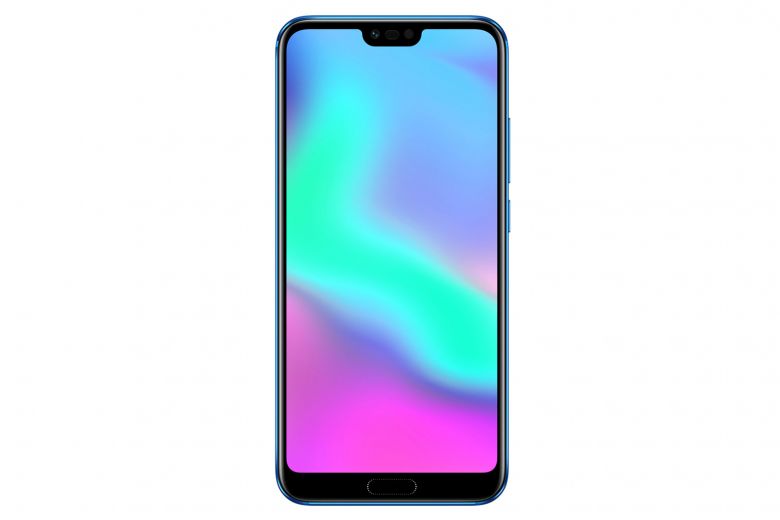
The Honor 10 is the latest flagship smartphone killer from Huawei’s budget sub-brand. With an ultra-competitive price of $579, it aims to unsettle bigger brands with a mix of premium and mid-range features.
In fact, it could threaten even its own stablemates. My first impression was that the Honor 10 makes the Honor View 10 ($599 at its launch in mid-April) obsolete. It could also give the Huawei P20 a run for its money, especially as the Honor 10 feels like a repackaged, discounted version of the P20.
Like the P20, the Honor 10 has an optical coating that causes the colour of its glass back to appear either blue or purple when viewed from different angles. This colour variant, dubbed Aurora, has been described as either attractive or tacky.
I do not mind the colour as much as the slippery feel of its smooth glass back. This, coupled with the large camera bump at the rear, means that the phone will slide off an uneven surface. A case is definitely recommended.
My biggest beef with the Honor 10 is the ultrasonic fingerprint sensor below its 5.84-inch screen. It is under the glass, making it impossible to locate the sensor by touch alone. This is annoying, especially in the dark.
In addition, it simply does not seem as accurate or as fast as a conventional fingerprint sensor. Fortunately, the phone can also be unlocked via facial recognition.
-
SPECS
- PRICE: $579
PROCESSOR: Kirin 970 (Quad-core 2.36GHz, quad-core 1.8GHz)
DISPLAY: 5.84-inch, IPS LCD, 2,280 x 1,080 pixels, 432 ppi pixel density
OPERATING SYSTEM: EMUI 8.1 (Android 8.1)
MEMORY: 128GB, 4GB RAM
REAR CAMERA: 16MP RGB (f/1.8) and 24MP monochrome
FRONT CAMERA: 24MP (f/2.0)
BATTERY: Non-removable 3,400mAh
-
RATING
- FEATURES: 4/5
DESIGN: 4/5
PERFORMANCE: 4/5
VALUE FOR MONEY: 5/5
BATTERY LIFE: 3/5
OVERALL: 4/5
It does not support wireless charging nor does it have water resistance. But then, there are no phones in this price segment that have such features. A less-common feature is the infrared blaster that can be used to control home applicances like the air-conditioner or the television.
It has dual rear cameras (colour and monochrome, like the Huawei P20), though without the P20’s Leica branding. Like many smartphones now, these cameras use artificial intelligence (AI) to identify specific scenes and objects (Honor says there are 22 scenarios, such as portrait and greenery) and automatically adjusts for the optimal settings. This feature works quite well and correctly makes out most everyday scenarios. It can be turned off easily in the camera interface with a button press.
Images turned out sharp and detailed with good colours. Portrait shots with the AI enabled have a natural bokeh effect while low-light photos have much less noise than other mid-range smartphones.
The front selfie camera supports simulated lighting effects like the ones on the iPhone, such as a circular stage light that illuminates the subject’s face while the background remains dark.
But these photos may not be everyone’s cup of tea because of the heavy post-processing. When zoomed in, faces, especially, look soft and smooth, thanks to the default beautification setting in the camera app. Turning it off reduces, but does not entirely disable, the processing.
Like Huawei’s latest P20 smartphones, the Honor 10 uses Huawei’s custom EMUI 8.1 interface based on Android 8.1. It tries hard to cater to everyone and seems to be influenced by both Apple and other Android smartphone makers.
For instance, you can switch between using an iOS-like home screen and an app drawer like most Android devices. If you dislike the screen notch, it can be disguised via a setting that darkens the notch’s surrounding areas. It is telling that EMUI offers four options for navigation, including a gesture-based method that does away with Android’s default navigation bar.
Overall, the phone performs as expected of a device powered by Huawei’s flagship Kirin 970 chip – fast and smooth.
Battery life is probably its weakest point. It lasted nine hours and 10 minutes in The Straits Times’ video-loop battery test with the screen set to maximum brightness.
• Verdict: A budget alternative to flagship smartphones, the Honor 10 has the build quality and performance to match more expensive models.















![How to get a Qatar Family Residence Visa? [ Updated ]2022](https://welcomeqatar.com/wp-content/uploads/2022/04/maxresdefault-2-324x400.jpg)









